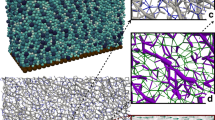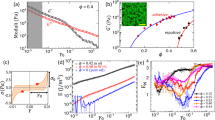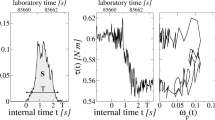Abstract
Dense granular flow is common in nature and industrial applications. A hallmark behaviour of granular flow is the emergence of a critical state when sufficient strain is applied, which has traditionally been understood with empirical constitutive theories. However, these theories are macroscopic ones without microscopic basis and, therefore, the physical origin of the critical state remains unknown. Here we demonstrate that the critical state corresponds to the random loose packing state where all the microstates are sampled with equal probability. X-ray tomography and shear force measurements allow us to monitor the microscopic processes of sheared granular materials and show that interparticle frictional contacts alter the density of states. This, consequently, leads to different critical state volume fractions. Despite this qualitative difference, we find universal equations of rescaled state variables (effective temperature, entropy and contact number as functions of volume fraction) for systems with different friction coefficients (μ = 0.52, 0.66 and 0.86), which suggests that frictional granular packings can be mapped directly to the frictionless hard-sphere system. In addition, we show that shear force barely affects the Edwards ensemble statistics, while its behaviour can be empirically explained by simply adding the contributions from particle structural rearrangements and frictional dissipation on contacts.
This is a preview of subscription content, access via your institution
Access options
Access Nature and 54 other Nature Portfolio journals
Get Nature+, our best-value online-access subscription
$29.99 / 30 days
cancel any time
Subscribe to this journal
Receive 12 print issues and online access
$209.00 per year
only $17.42 per issue
Buy this article
- Purchase on Springer Link
- Instant access to full article PDF
Prices may be subject to local taxes which are calculated during checkout




Similar content being viewed by others
Data availability
All data that support the plots within this paper and other findings of this study are available from the corresponding authors upon reasonable request. Source data are provided with this paper.
References
de Gennes, P. G. Granular matter: a tentative view. Rev. Mod. Phys. 71, 374–382 (1999).
Andreotti B., Forterre, Y. & Pouliquen, O. Granular Media: Between Fluid and Solid (Cambridge Univ. Press, 2013).
Schofield, A. & Wroth, P. Critical State Soil Mechanics (McGraw-Hill, 1968).
Mesarovic, S. D., Padbidri, J. M. & Muhunthan, B. Micromechanics of dilatancy and critical state in granular matter. Géotech. Lett. 2, 61–66 (2012).
Onoda, G. Y. & Liniger, E. G. Random loose packings of uniform spheres and the dilatancy onset. Phys. Rev. Lett. 64, 2727–2730 (1990).
Nicolas, A., Ferrero, E. E., Martens, K. & Barrat, J.-L. Deformation and flow of amorphous solids: insights from elastoplastic models. Rev. Mod. Phys. 90, 045006 (2018).
Sollich, P., Lequeux, F., Hébraud, P. & Cates, M. E. Rheology of soft glassy materials. Phys. Rev. Lett. 78, 2020 (1997).
Falk, M. L. & Langer, J. S. Deformation and failure of amorphous, solidlike materials. Annu. Rev. Condens. Matter Phys. 2, 353–373 (2011).
Haxton, T. K. & Liu, A. J. Activated dynamics and effective temperature in a steady state sheared glass. Phys. Rev. Lett. 99, 195701 (2007).
Kou, B. et al. Granular materials flow like complex fluids. Nature 551, 360–363 (2017).
Wang, D., Ren, J., Dijksman, J. A., Zheng, H. & Behringer, R. P. Microscopic origins of shear jamming for 2D frictional grains. Phys. Rev. Lett. 120, 208004 (2018).
Bi, D., Zhang, J., Chakraborty, B. & Behringer, R. P. Jamming by shear. Nature 480, 355–358 (2011).
Sun, J. & Sundaresan, S. A constitutive model with microstructure evolution for flow of rate-independent granular materials. J. Fluid Mech. 682, 590–616 (2011).
da Cruz, F., Emam, S., Prochnow, M., Roux, J. N. & Chevoir, F. Rheophysics of dense granular materials: discrete simulation of plane shear flows. Phys. Rev. E 72, 021309 (2005).
Rothenburg, L. & Kruyt, N. P. Critical state and evolution of coordination number in simulated granular materials. Int. J. Solids Struct. 41, 5763–5774 (2004).
Puckett, J. G. & Daniels, K. E. Equilibrating temperature-like variables in jammed granular subsystems. Phys. Rev. Lett. 110, 058001 (2013).
Henkes, S., O’Hern, C. S. & Chakraborty, B. Entropy and temperature of a static granular assembly: an ab initio approach. Phys. Rev. Lett. 99, 038002 (2007).
Bi, D., Henkes, S., Daniels, K. E. & Chakraborty, B. The statistical physics of athermal materials. Annu. Rev. Condens. Matter Phys. 6, 63–83 (2015).
Yuan, Y. et al. Experimental test of the Edwards volume ensemble for tapped granular packings. Phys. Rev. Lett. 127, 018002 (2021).
Makse, H. A. & Kurchan, J. Testing the thermodynamic approach to granular matter with a numerical model of a decisive experiment. Nature 415, 614–617 (2002).
Babu, V., Pan, D., Jin, Y., Chakraborty, B. & Sastry, S. Dilatancy, shear jamming, and a generalized jamming phase diagram of frictionless sphere packings. Soft Matter 17, 3121–3127 (2021).
Song, C., Wang, P. & Makse, H. A. A phase diagram for jammed matter. Nature 453, 629–632 (2008).
Briscoe, C., Song, C., Wang, P. & Makse, H. A. Entropy of jammed matter. Phys. Rev. Lett. 101, 188001 (2008).
Pan, D., Ji, T., Baggioli, M., Li, L. & Jin, Y. L. Nonlinear elasticity, yielding, and entropy in amorphous solids. Sci. Adv. 8, eabm8028 (2022).
Angelani, L. & Foffi, G. Configurational entropy of hard spheres. J. Phys. Condens. Matter 19, 256207 (2007).
Charbonneau, P., Kurchan, J., Parisi, G., Urbani, P. & Zamponi, F. Fractal free energy landscapes in structural glasses. Nat. Commun. 5, 3725 (2014).
Vinutha, H. A. & Sastry, S. Disentangling the role of structure and friction in shear jamming. Nat. Phys. 12, 578–583 (2016).
Xia, C. et al. The structural origin of the hard-sphere glass transition in granular packing. Nat. Commun. 6, 8409 (2015).
Kumar, N. & Luding, S. Memory of jamming–multiscale models for soft and granular matter. Granul. Matter 18, 58 (2016).
Zhang, J. et al. Unifying fluctuation-dissipation temperatures of slow-evolving nonequilibrium systems from the perspective of inherent structures. Sci. Adv. 7, eabg6766 (2021).
Jin, Y. & Yoshino, H. A jamming plane of sphere packings. Proc. Natl Acad. Sci. USA 118, e2021794118 (2021).
Parisi, G. & Zamponi, F. Mean-field theory of hard sphere glasses and jamming. Rev. Mod. Phys. 82, 789–845 (2010).
Xing, Y. et al. X-ray tomography investigation of cyclically sheared granular materials. Phys. Rev. Lett. 126, 048002 (2021).
Cao, Y. et al. Structural and topological nature of plasticity in sheared granular materials. Nat. Commun. 9, 2911 (2018).
Zhang, L. & Thornton, C. A numerical examination of the direct shear test. Geotechnique 57, 343–354 (2007).
Koumakis, N., Laurati, M., Egelhaaf, S. U., Brady, J. F. & Petekidis, G. Yielding of hard-sphere glasses during start-up shear. Phys. Rev. Lett. 108, 098303 (2012).
Aste, T., Saadatfar, M. & Senden, T. J. Geometrical structure of disordered sphere packings. Phys. Rev. E 71, 061302 (2005).
Acknowledgements
The work was supported by the National Natural Science Foundation of China no. 11974240 (Y.X., H.Y., S.Z. and Y.W.) and no. 11904102 (C.X.); the Science and Technology Innovation Foundation of Shanghai Jiao Tong University no. 21X010200829 (Y.X., Y.Y., H.Y., S.Z., Z.Z. and Y.W.); the China Postdoctoral Science Foundation no. 2021M702151 (Y.Y.); and the Science and Technology Commission of Shanghai Municipality no. 22YF1419900 (Y.W.).
Author information
Authors and Affiliations
Contributions
Y.W. designed the research. Y.X., Y.Y., H.Y., S.Z., Z.Z., X.Z., C.X. and Y.W. performed the experiment. Y.X., C.X. and Y.W. analysed the data and wrote the paper.
Corresponding authors
Ethics declarations
Competing interests
The authors declare no competing interests.
Peer review
Peer review information
Nature Physics thanks the anonymous reviewers for their contribution to the peer review of this work.
Additional information
Publisher’s note Springer Nature remains neutral with regard to jurisdictional claims in published maps and institutional affiliations.
Supplementary information
Supplementary Information
Supplementary Notes 1 and 2.
Source data
Source Data Fig. 1
Data accompanying Fig. 1.
Source Data Fig. 2
Data accompanying Fig. 2.
Source Data Fig. 4
Data accompanying Fig. 4.
Rights and permissions
Springer Nature or its licensor (e.g. a society or other partner) holds exclusive rights to this article under a publishing agreement with the author(s) or other rightsholder(s); author self-archiving of the accepted manuscript version of this article is solely governed by the terms of such publishing agreement and applicable law.
About this article
Cite this article
Xing, Y., Yuan, Y., Yuan, H. et al. Origin of the critical state in sheared granular materials. Nat. Phys. 20, 646–652 (2024). https://doi.org/10.1038/s41567-023-02353-4
Received:
Accepted:
Published:
Issue Date:
DOI: https://doi.org/10.1038/s41567-023-02353-4



